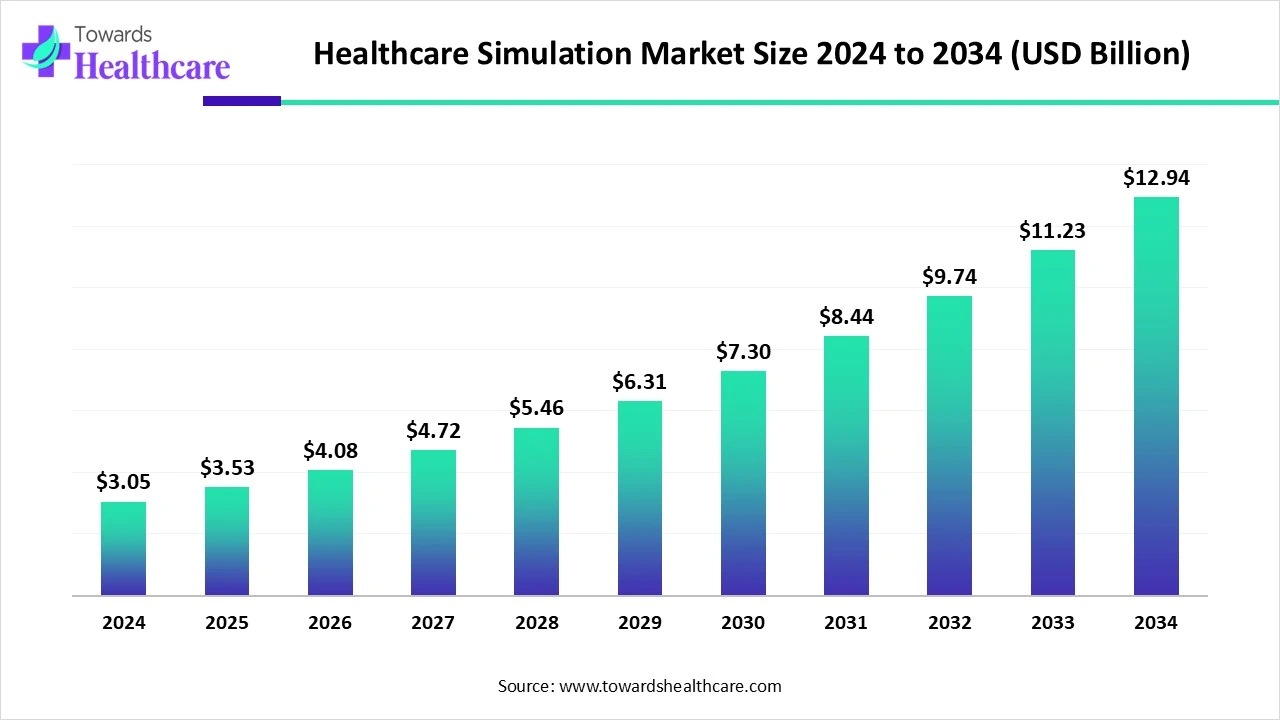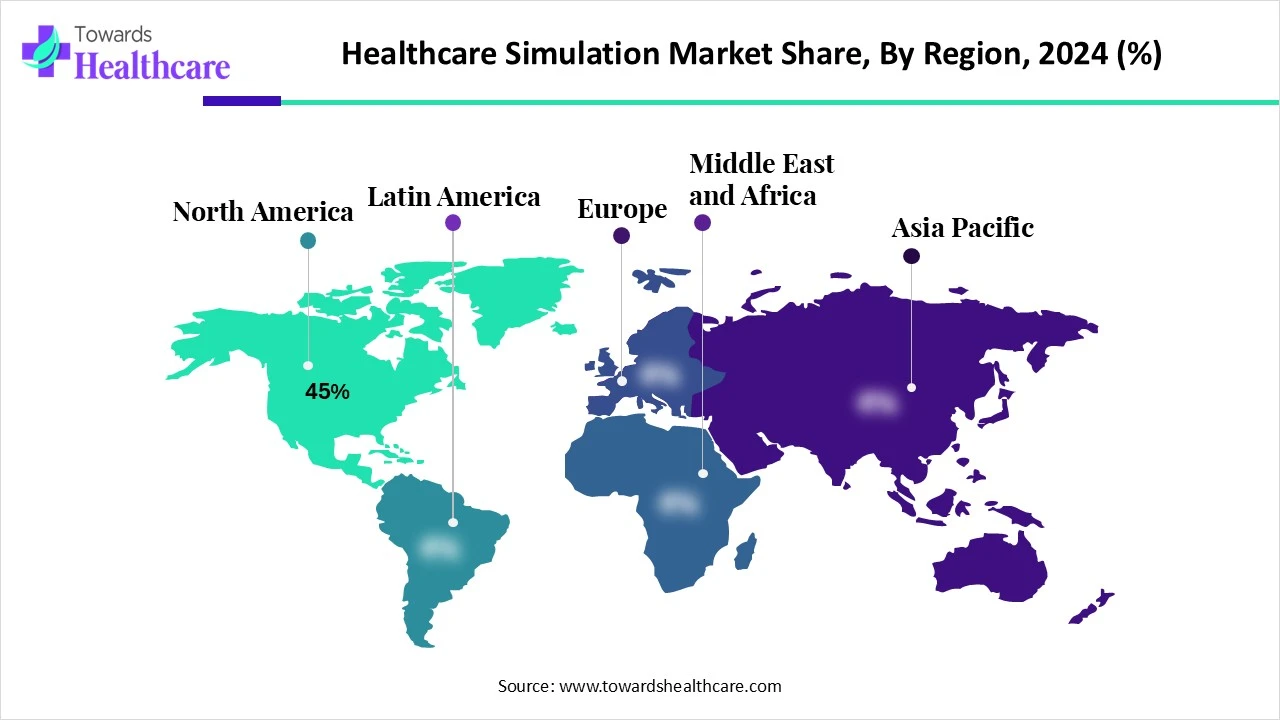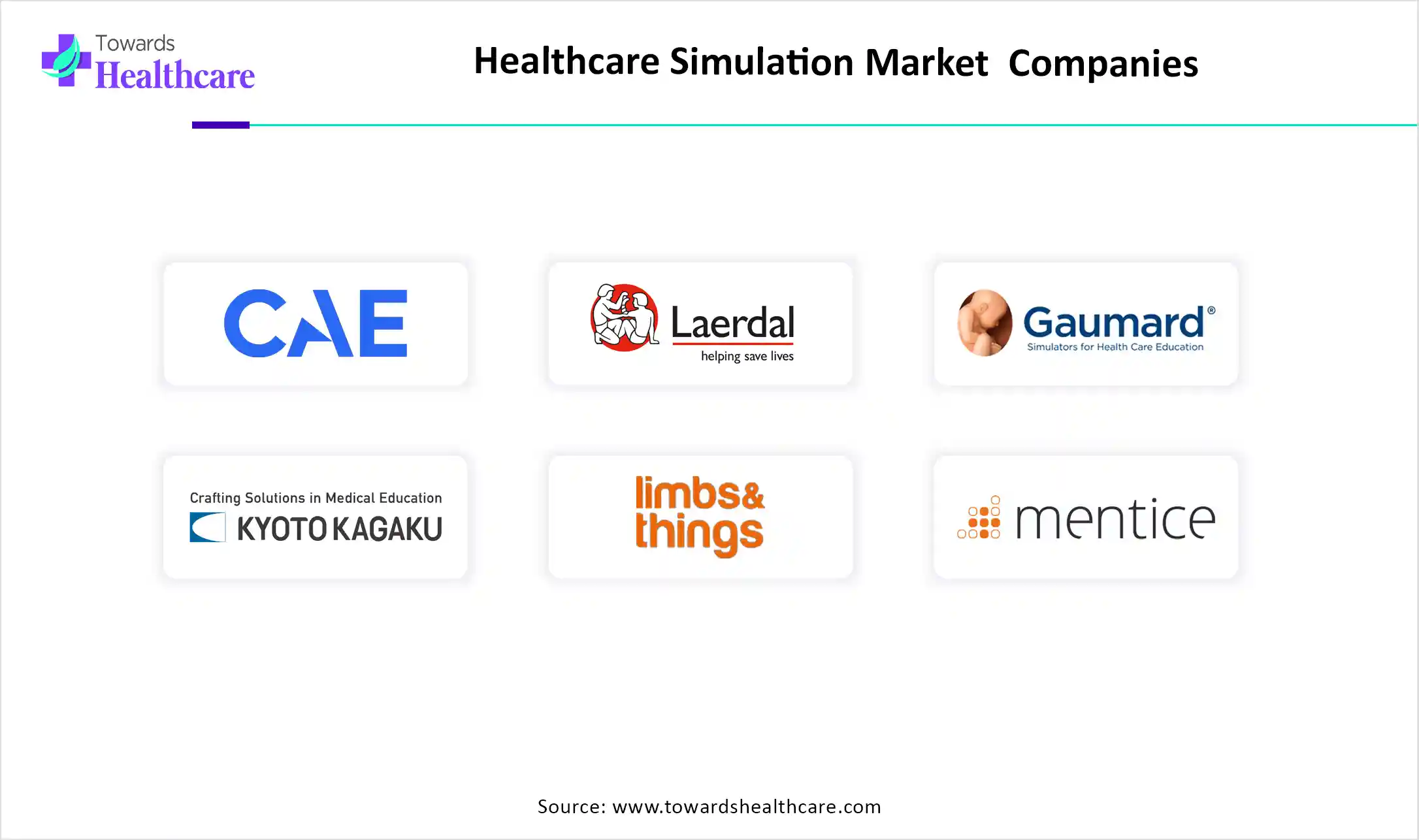November 2025

The global healthcare simulation market size is calculated at US$ 3.05 billion in 2024, grew to US$ 3.53 billion in 2025, and is projected to reach around US$ 12.94 billion by 2034. The market is expanding at a CAGR of 15.54% between 2025 and 2034.

One of the main factors propelling the healthcare simulation market is the rising emphasis on patient safety, which has raised the need for simulation-based training among medical professionals. Since reducing medical errors is a primary aim for healthcare systems worldwide, investing in simulation technology has become essential to ensuring high levels of care. The ongoing development of digital technologies like virtual reality and augmented reality is also improving the training experience, which makes medical simulations more realistic and effective.
| Table | Scope |
| Market Size in 2025 | USD 3.05 Billion |
| Projected Market Size in 2034 | USD 12.94 Billion |
| CAGR (2025 - 2034) | 15.54% |
| Leading Region | North America Share 45% |
| Market Segmentation | By Product Type, By Technology, By End User, By Region |
| Top Key Players | CAE Inc., Laerdal Medical, Gaumard Scientific, Kyoto Kagaku, Limbs & Things, Mentice AB, Simulab Corporation, Surgical Science Sweden AB, 3D Systems Corporation, Osso VR |
The healthcare simulation market encompasses technologies and methodologies that replicate real-world medical scenarios to train healthcare professionals. These simulations range from high-fidelity mannequins and virtual reality environments to task trainers and web-based platforms. The primary aim is to enhance clinical skills, improve patient safety, and reduce medical errors. The market's growth is propelled by the increasing complexity of medical procedures, the need for standardized training, and advancements in simulation technologies.
Government Efforts to improve healthcare in remote areas: One of the major issues faced by healthcare service providers and governments is providing healthcare services to remote areas. Not only is it costly, but requires a lot of effort to provide basic services. Due to this, the governments are taking efforts to provide healthcare access to people living in remote areas.
Enhancing training efficacy, optimising learning outcomes, and eventually improving patient care are all potential benefits of integrating AI and ML into healthcare simulation. Although AI and ML have been used for a while in fields like radiology and surgery, nursing education, more especially, nursing simulation education, has just recently begun to employ them. AI is being used by academics and educators to improve interprofessional communication abilities. Teachers may replicate the intricacies of actual clinical encounters by creating realistic and flexible situations with AI-powered virtual patients.
Rise in Remote Patient Monitoring Drives the Healthcare Simulation Market
In certain respects, AR and VR technology improves in-person treatment while enabling physicians to provide remote patient care beyond geographic limitations. Healthcare systems are beginning to realise the significant influence that telehealth and AR/VR will have on a variety of healthcare services. With the advent of AR and VR, physicians can overcome a variety of telemedicine obstacles, including as managing patients, performing virtual and less invasive procedures, and accurately diagnosing patients.
Lack of Context-Appropriate Curriculum
Numerous studies have identified the absence of a context-appropriate curriculum as a significant obstacle to the adoption of an embedded or simulation-enabled curriculum in low- and middle-income nations. Creating and implementing a simulation programme that fits the clinical setting is difficult.
What are the Opportunities in the Healthcare Simulation Market?
In the future, the development of simulation-based learning and the creation of initiatives like EuroHealthSim will be essential to satisfying the changing demands of medical professionals. Simulation will continue to be a vital component of health care education thanks to the dedication to research, innovation, and teamwork, which will eventually improve patient care and safety. Additionally, technology may improve the efficacy and realism of simulations, offering individualised learning experiences catered to each learner's need. The growing cooperation between academic institutions, healthcare organisations, and business partners is another interesting trend.
By product type, the healthcare anatomical models segment captured the major share of the market in 2024. To fully understand the intricacy of human structure, anatomical models are crucial resources. Medical instructors, students, healthcare workers, and clinical training environments all benefit greatly from the practical learning experience provided by these scientifically precise replicas. Showcasing structural detail, spatial connections, and physiological function, each anatomical model is painstakingly created to provide genuine anatomical correctness. Students and professionals may study anatomical structures from a variety of angles, at any time, anywhere, thanks to this combination of digital interaction and physical realism, which further supports blended learning and the demands of digital curricula.
By technology, the procedural rehearsal technology segment led the healthcare simulation market in 2024. The use of procedural simulation will revolutionise the way medical professionals keep up their expertise. Interventional specialities will be at the forefront of this change, and visionary leaders are already looking at how this teaching method will be incorporated into conventional curriculum. It is necessary to identify the function that simulation will play, create new teaching models around it, and conduct research that will satisfy the needs of a profession that is sceptical.
By end-user, the academic institutes segment held the major share of the healthcare simulation market in 2024. Healthcare simulation is being used more and more by academic institutions to improve training for medical and healthcare professionals. To produce realistic clinical settings for skill development and evaluation, these institutions use a variety of simulation technologies, including as virtual reality, standardised patients, and high-fidelity mannequins. With this method, students may hone their decision-making skills, strengthen their collaboration, and rehearse protocols in a secure setting.

North America dominated the healthcare simulation market share by 45% in 2024. Strong government backing, considerable expenditures in healthcare infrastructure, and cutting-edge technical advancements are driving the market for medical simulations in North America. The significance of providing high-quality healthcare services is emphasised by North American government programmes, and simulation-based education is essential for lowering medical mistakes and improving clinical competence. Healthcare personnel have access to cutting-edge training resources thanks to significant financing from the public and commercial sectors that supports the establishment and growth of simulation centres. Partnerships with top academic institutions and international organisations promote the sharing of best practices and expertise, which raises the standard of simulation training even further.
In July 2025, the Trump Administration said that it is working with creative private sector entrepreneurs to create a healthcare system that is smarter, more secure, and more personalised. Major information technology and healthcare companies, such as Amazon, Anthropic, Apple, Google, and OpenAI, committed to helping the administration start building a next-generation digital health ecosystem that will enhance patient outcomes, lessen the burden on providers, and create value. Over 60 businesses committed to collaborating to provide outcomes for the American people in 2026's first quarter. Furthermore, over the next few months, 30 businesses promised to use technology to advance actual health outcomes.
Rural and isolated areas now have prompt access to health evaluation and treatment thanks to new virtual care delivery techniques. People who have trouble obtaining health services throughout Canada can be reached through virtual care. To promote ongoing alignment between governments and stakeholders, a responsive governance strategy and a pan-Canadian vision are required. CNA suggests creating a government digital health policy that would address patient and provider digital literacy gaps, recognise virtual care as a fundamental part of Canada's healthcare system, and guarantee fairness and cultural safety.
Asia Pacific is estimated to host the fastest-growing healthcare simulation market during the forecast period. The demand for cutting-edge training techniques like medical simulation is rising as a result of the Asia-Pacific region's significant expansion in healthcare infrastructure and medical education. Additionally, the usage of medical simulation is growing as governments in the Asia-Pacific area take action to enhance patient safety and healthcare quality. Healthcare facilities are being encouraged to invest in simulation technology by these government-led initiatives in order to enhance patient outcomes and the abilities of medical staff.
China is positioned as a potential worldwide leader in DTx due to its vast population, quick adoption of new technologies, and encouraging government regulations. The DTx market in China has seen tremendous expansion and demand as a result of growing healthcare awareness. China's DTx has expanded rapidly, surpassing that of the majority of Western nations, particularly in e-commerce-related health care domains.
In order to significantly improve the delivery of public healthcare, the Ministry of Health and Family Welfare, Government of India, has recognised the potential of digital health to transform healthcare delivery. It has implemented effective monitoring and evaluation platforms and promoted digital health, which is the use of information and communication technology in the direction of "reaching services to citizens" and "citizen empowerment through information dissemination."
Europe is expected to grow at a significant rate in the healthcare simulation market during the forecast period. with nations like France, Germany, and the United Kingdom leading the way. These countries promote a strong market environment by placing a high priority on healthcare innovation and training. The region's market development is facilitated by the European Union's financing and favourable rules for medical education. Furthermore, simulation technology growth is aided by Europe's growing need for minimally invasive operations.

In April 2025, the new center's opening was hailed by MTU President Professor Maggie Cusack, who said, "This Simulation Centre will provide world-class education and training for the next generation of healthcare professionals." Immersion learning activities that replicate actual medical situations in a safe setting will be advantageous to our students. This is a significant accomplishment for MTU. The Simulation Centre is a landmark in our university's history and a representation of our dedication to quality and innovation in education.
By Product Type
By Technology
By End User
By Region
Based on market forecasts, the APAC life science market, projected at USD 17.51 billion in 2024, is expected t...
According to forecasts, the global cell-free protein expression market will grow from USD 315.03 million in 20...
Based on market forecasts, the global clear aligners market, projected at USD 6.51 billion in 2024, is expecte...
November 2025
November 2025
November 2025
November 2025